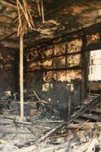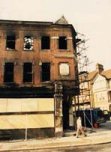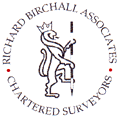Fire Insurance Valuations
Services
We prepare and negotiate claims with loss adjusters and can implement reinstatement work. Types of BuildingsWe calculate the "bricks and mortar" sum insured for:
The type of building influences the method of calculation of the sum insured but the principles are similar. 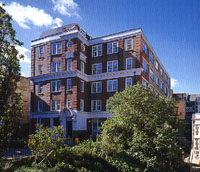
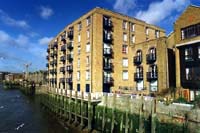
Purpose The purpose of insurance is to protect the building owner against the unwanted and the unexpected. The principle - if a loss occurs, the building owner, the insured, should be put back in a position comparable to that before the loss occurred.
Alternatives - Reinstatement or Indemnity? Reinstatement cost has been defined as: The cost of demolishing and clearing away the existing structure and rebuilding it to the existing design in modern materials, using modern techniques, to a standard equal to the existing property and in accordance with current Building Regulations and other statutory requirements. Indemnity is related to the value of the asset and takes into account the age, state of repair and suitability for use of the property. It makes deduction for wear and tear. Insurance PoliciesBecause of the different methods of assessment used, it is essential that a building owner and his surveyor understand the terms of the insurance policy for the particular building. If the policy is not understood, the sum insured may be calculated on the incorrect basis and the building owner left with losses which could otherwise have been insured. If in doubt as to the wording of the policy the advice of the insurance broker or insurance company should be sought. Single Houses and Flats Reinstatement cost assessments for conventional houses and flats can be most easily assessed by reference to the Guide to House Rebuilding Costs prepared annually on behalf of The Association of British Insurers by The Building Cost Information Service of The Royal Institution of Chartered Surveyors. The guide contains tables of typical houses and flats with options for the principal factors of location, type, age, size, quality and location. It is a ready reckoner, to which the chartered surveyor must apply his own local knowledge, skill and judgement before confirming the results of the calculation as being the recommended sum insured. Such valuations are routinely provided with mortgage and open market valuations, usually without addition fee due to the simplicity of calculation and the relatively low risk of error due to the orthodox nature of building being valued. Houses and flats which are not single or conventional, and in particular large or listed houses and blocks of flats, are not covered by advice in the tables and must be individually assessed by use of standard quantity surveying methods. Fire insurance and special perils Insurance policies provide cover in the event of loss or damage to the buildings caused by some or all of the following: 
Sum Insured The basis of valuation is that the assessments will include all items except lessees' / tenants' contents. Specifically the valuations will include:
Where appropriate it is important to ensure that the buildings will have cover against terrorism. Average The "rule" by which, if the building owner cheats or his sums are wrong, he can expect the insurers to pay only a percentage of the loss. Therefore, is the building is only insured for half of what it would cost to rebuild, the payment will be half of the loss. The rule applies even if the claim is well below the sum insured. Reinstatement Cost (correct) £2,000,000 Building Sum Insured (actual) £1,000,000 Claim £ 100,000 Payment £ 50,000 The building owner is assumed to have insured the difference himself with the premium he has saved. If, however, the building is over-insured the reverse does not apply and there is no profit, simply a wasted over-payment of premium. It is therefore worthwhile ensuring that the reinstatement cost is correctly calculated. Betterment The principle is not applied to reinstatement (new for old) policies. When a policy is on an indemnity basis the insurers will require a contribution towards the costs of any improvements resulting from the works. If an item is 50% of the way through its expected life, the insurers will pay half the cost and the building owner must pay the balance. Inflation It is most important that the sum insured increase in line with building costs, because if it does not do so the building might be seriously underinsured. Many commercial buildings are insured on a "Day One basis". It is not the method normally used for the insurance of residential property. Insurance on a "Day One basis" assumes that all necessary works of reinstatement can be carried out for building costs applicable on day one of the policy, the "declared sum". That cannot happen. The "declared sum" has to be adjusted for various price rises and other factors:
The basis of a rebuilding cost valuation is the cost of totally rebuilding the insured property. There is no VAT guidance on the specific subject of fire damage and reinstatement. VAT Leaflet No 708 "Buildings and Construction" states that "The construction of a building making use of a part or all of the foundations of an existing building, where the former has been demolished to foundation level" is zero-rated work. VAT is therefore at present not applicable to total rebuilding and the reinstatement costs will make no allowance for VAT on building costs or demolition. VAT has to be paid on professional fees and will be included. VAT has been payable on new construction (except housing) from 1 April 1989. Unless the building damaged is totally destroyed and complete reconstruction is required, the reinstatement would fall under repair and maintenance, which in all cases is standard rated. VAT would, however, be payable in the case of a partial loss and for this reason it is common practice with such buildings to assess VAT on 95% of the reinstatement value, as in the event of a "worst case" loss VAT would not normally be recoverable by the managing agents of a residential building. The VAT element of a valuation will be a significant sum. Building Owners are therefore advised to obtain confirmation from Customs and Excise that in the event of a loss the VAT element would be recoverable. When the insured is unable to obtain such confirmation, or knows that VAT would not be recoverable, then the sum insured should include VAT. Reports Unless instructed otherwise, we prepare a written report on each individual property. Although the "bottom line" figure is usually all that is required by the insurers, in the event of the sum insured being questioned the report will confirm that it has been assessed in accordance with good practice and will show the methodology employed. The report would normally make reference to the following headings:
Loss of rent The assessment of sums insured for fire insurance purposes, other than for single houses or flats, is normally divided within the office as follows: Richard Birchall will personally visit and inspect each property and prepare the reports. Mark Allen, quantity surveyor, will carry out special research on the reinstatement cost and will check the rates per square foot. These rates will be cross checked with data available in the office and information available from the Building Cost Information Service of the RICS. Time Scale On receipt of an enquiry we will discuss a time scale with the client you and the order of priority for receiving the reports. Information Supplied Information provided by the building owner, including any sales brochures and plans will assist us to assess the time it is likely to take to visit the property / properties, assess the standard of construction, and hence the time engaged and the appropriate fee. Access Although drawings may be available we do require to inspect all buildings to check the overall dimensions, as it is not acceptable practice to rely solely on the drawings and agents' details. Fees Fees are assessed and confirmed individually. Fees are calculated on a basis which allows adequate time for the job to be executed properly and makes due allowance for the risk element. In general: Single houses and flats A reinstatement cost assessment will be included at no charge if the work is carried out at the same time as a mortgage or open market valuation, or building survey. If the instruction is a separate instruction then the RICS scale fee below will normally apply. Blocks of Flats A fee to be confirmed, depending upon the size and number of buildings, the sum insured and the risk. For portfolio valuations our fees are typically 75% of the RICS scale fee. RICS Scale BS5 The Royal Institution of Chartered Surveyors publishes a recommended scale of charges for such work, Scale BS5. 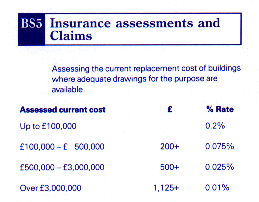
Fire Damage Reinstatement: An Information Paper, 1997. London: RICS Books Guide to Carrying Out Reinstatement Cost Assessment Guidance Note, 1999. London: RICS Books. Guide to House Rebuilding Costs for Insurance Valuation RICS Building Cost Information Service, 1999, 1998 Oaks, A J. Fire Insurance Risks and Claims 1997. London: Blackwell The Insurance of Managed Property, 1995. London: RICS Books Property Insurance - Some Points to Consider in Relation to the Proper Cover of Risks (4th edition), 1995. London RICS Books Reinstatement Assessments for Insurance Purposes Practice Note No 3, RICS 1980 Reinstatement Cost Assessment and Insurance Claims, 2nd edition, 1995. London: RICS Books Updated 13 October 2001 15:30 |


